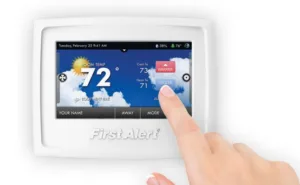Display panel manufacturers are seeking new outlets for their products, now that the smartphone, tablet, and television markets have matured and appear to be stabilizing. One possible application for more displays is the use in “smart home” applications. At CES 2015, we saw a number of examples of this but perhaps the most interesting was the use of full color touch screens on thermostats. Compared with the usual passive LCD segmented display, these panels offer much greater customization for the user, show more information, and are easier to read.
For example, the OneLink WiFi Thermostat from First Alert (http://www.firstalertthermostats.com/) comes with a color touch screen. The touch screen eliminates the need for separate, physical control buttons. The screen can make it clear where to touch in order to raise or lower the temperature. The contents of the screen can change depending on the features that the user wants at a given time, which simplifies the user interface. And users can load up to 100 of their own photographs, which can then be used as “wallpaper” background for the display. The thermostat can also turn into a digital photo frame, displaying a slide show of your pictures when idle.
The thermostat can also be controlled by an app on your Android or iOS smartphone or tablet, using a WiFi connection in your home. This lets you monitor the temperature in your home even when you’re away, and gives you control over the thermostat settings. The app also lets you monitor your energy usage for the past seven days.
The product is not shipping yet, but is available for pre-order on Amazon. The display and connectivity features do boost the price considerably; it will sell for about $230, which is in line with similar color touch screen products from Honeywell and Venstar.
Display Daily Comment
Whether this application will result in the sale of significant numbers of panel sales remains to be seen. There certainly a large numbers of homes being built every year worldwide. On the other hand, thermostats tend to be a “set and forget” device in most homes, and users have little need to interact with them. As a result, the added user interface benefits may not be enough to justify the additional cost compared with traditional “dumb” thermostats that cost much less. – Alfred Poor
(I’m reminded of the comment from Paul Gray of DisplaySearch about clever remote controls – they are a $100 solution to a $5 problem… (BR)

